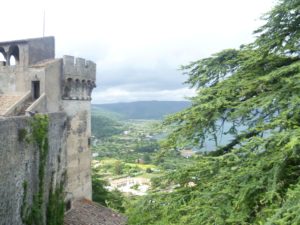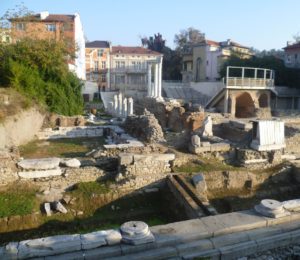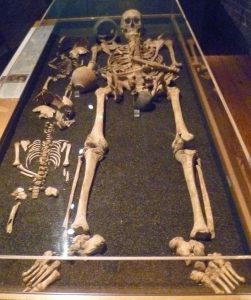When I went on a ‘Roman Germany’ holiday a few years ago, the last thing I was expecting to see was superb Roman glass that had actually been made there. I knew that, during the Roman Empire, Rome had occupied parts of Germany to the east of the Rhine for several hundred years but I’d imagined a rough Frontier existence with evidence of Roman forts, siege warfare, and Roman armour – not sophisticated, top-quality glass!
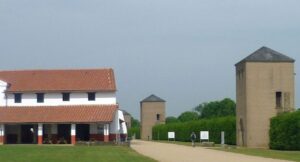
Xanten – a reconstructed Roman fort in Germany; purely military – no fancy glass here, surely.
I was wrong. Cologne, for example, had started life as Oppidum Ubiorum, one of the Roman fortresses set up by the Emperor Augustus in about 10 B.C. It became part of ‘Germania Inferior’ – that is Lower Germany, the area nearest to the Rhine Estuary. Oppidum Ubiorum and the surrounding territory of Germania Inferior was not so much ruled by Rome directly, it was more an area within Rome’s influence – the Roman Empire’s boundaries tended to be fluid rather than rigid. In due course, Augustus extended the Imperial frontier to include Germania Superior (Upper Germany) and, eventually, 40 forts stretched along the Rhine; he planned to use them as stepping stones to extend the Roman Empire eastwards as far as the River Elbe.

One of the remaining Roman towers along the city walls of Colonia Claudia Agrippinensis.
Fast forward 60 years or so, and Oppidum Ubiorum was given a new name: Colonia Claudia Agrippinensis, after the Emperor Claudius’s wife who was born there – hence the name Cologne, or Köln, which it bears today. I was beginning to see that the Roman presence in Germany was much more intentional that I had thought.

Reconstructed Roman scaffolding at the Roman fort at Xanten. Nothing fancy, but it was efficient
This is how the Roman system worked: the military garrisons occupying the Rhine land comprised about 80,000 men. Reliable links were essential if they were to expand eastward and secure the Frontier against the Germanic tribes to the east; some of whom were friendly but others were definitely not. Roads, bridges, forts etc. all had to be built, secured, garrisoned, fed and maintained; the Romans also needed to forge and nurture alliances with friendly tribes on both sides of the Rhine. In other words, the Romans set out to create an autonomous economic zone in Germania Inferior – the land which they now occupied, and had named – in which everyone, soldiers as well as civilians could thrive – and could be taxed.

Partial reconstruction of the obligatory military temple to Jupiter, Juno and Minerva at Xanten
The Emperor, and those who governed Germania Inferior, were also anxious to promote the Roman way of life: the military garrisons needed pottery, for example, leather goods, wool and linen for clothes and furnishings, carpenters, wheelwrights, builders, stonemasons and so on. Every garrison town had a temple to Jupiter, Juno and Minerva; a Mithraeum, and other communal buildings, like baths. Somebody had to oversee all that building.
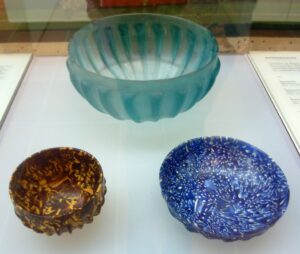
Roman glass bowls from the Roman fort at Saalberg; officers could expect the best.
Then there were the veterans, soldiers who had served their 40 years’ service and been granted money and land. They wanted to settle, in comfort, near their old legions – and, of course, Rome could call upon them, if she suddenly needed any military back-up. Roman urban prosperity would mean that the amenities the Romans were used to: comfortable homes with central heating, water on tap, a proper sewerage system, public baths, places to eat out or have a drink, not to mention shops, were not just desirable but necessities if Cologne were to thrive. Merchants, too, came to settle in Cologne: the roads were there; the river provided transport; and, in AD 310, the Emperor Constantine the Great built a bridge over the Rhine.

Roman glass ewer, I love the trailing swirls of colour: white, blue and gold.
Cologne gradually became a city which expected luxury. Cologne’s fine white clay encouraged top quality pottery; and around 100 A.D. the almost pure quartzite found nearby began to be mined for the production of glass.
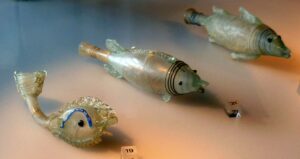
These wonderful glass fish are in the Römisch-Germanisches Museum in Cologne. I just love their quirkiness, not to mention the skill with which they were made.
As I said at the beginning of my post, Roman glass-making came as a complete surprize to me. Most of the glass objects in the museum were found in Roman or Frankish graves; and it was obvious that the delicate glass objects must have been both costly and highly valued.
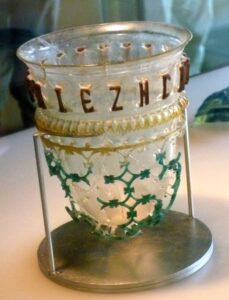
The Cologne glassmakers specialized in ‘cage cups’ where a decorated glass cup nestled inside an intricate cage of glass.
The cup pictured above is being held upright by a modern metal holder. Heaven knows how it stood up originally.
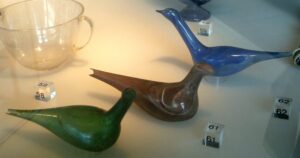
Glass birds
These were the first glass objects I saw in the Museum. I couldn’t make out how they stood up without rolling over – perhaps the bases are flattened slightly. Nor do I know what they are for. But they are plainly things of beauty and they came in different colours, (most people like to collect things in sets).
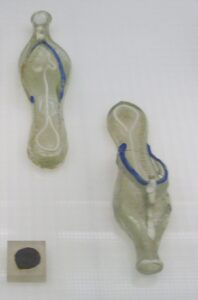
Glass slippers – shades of Cinderella?
For me, the glass objects that are obviously just decorative – like the glass slippers above, or the glass birds, or the fishes, are the most poignant. We know that they were grave goods that their owners obviously treasured and wanted to take them with them to the Afterlife, and I’m sure that all those beautifully created little glass masterpieces have stories to tell.
What I love about travelling is that you never know what you are going to find; the important thing is to keep an open mind.
All photographs by Elizabeth Hawksley ©
Elizabeth travelled with Andante Travels
© Elizabeth Hawksley
Please share this page...

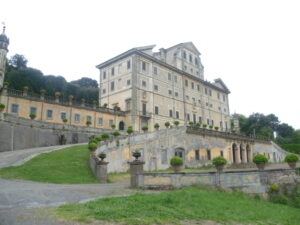
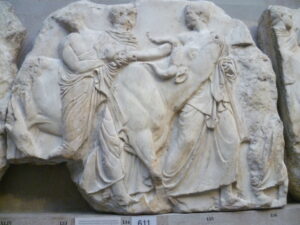
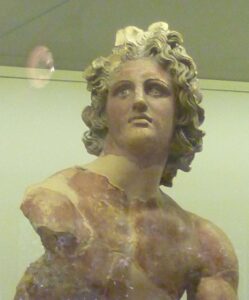
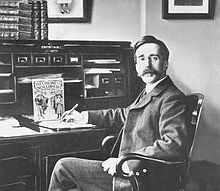
 The Decumanus Maximus, the well-preserved main street in Ostia Antica
The Decumanus Maximus, the well-preserved main street in Ostia Antica